Lisburn, Co. Antrim
Lisburn Poor Law Union was formed on 8th January 1839, and covered an area of 186 square miles. Its operation was overseen by an elected Board of Guardians, 29 in number, representing its 27 electoral divisions as listed below (figures in brackets indicate numbers of Guardians if more than one):
Co. Antrim:
Ballyscolly, Derryaghy, Glenavy, Island Kelly, Knocknadona, Legatirriff, Lisburn (3), Lissue, Magheragall, Magheramesk, Malone, Tullyrusk.
Co. Down:
Annahill, Ballykeel, Ballymacbrennan, Ballyworfy, Blaris, Breda, Dromara, Drumbeg, Drumbo, Glasdrummin, Hillsborough, Killany, Maze, Ouley, Saintfield.
The Board also included 9 ex officio Guardians, making a total of 38. The Guardians met each week on Tuesday at noon.
The population falling within the Union at the 1831 census had been 71,308 with divisions ranging in size from Magheragall (population 1,182) to Lisburn itself (5,745).
The new workhouse, built in 1841, was designed by George Wilkinson. It occupied a six-acre site on Hillsborough Road to the south of Lisburn and could accommodate 800 inmates. The cost of the building was £6,200 plus £1,358 for fixtures and fittings etc. It was declared fit for the admission of paupers on 1st January 1842, and admitted its first inmates a few weeks later on the 11th February. The site location and layout are shown on the 1904 map below.
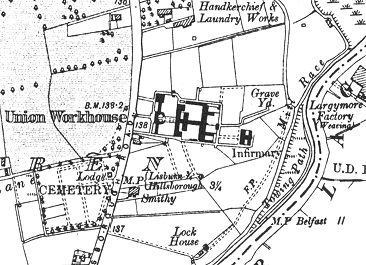
Lisburn workhouse site, 1904.
The buildings followed Wilkinson's typical layout. An entrance and administrative block at the west, now demolished, contained a porter's room and waiting room at the centre with the Guardians' board room on the first floor above. It was later extended at the north with the addition of children's school-rooms and dormitories.
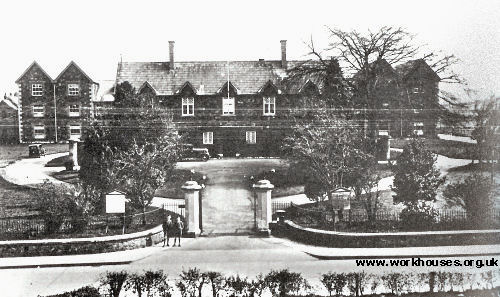
Lisburn workhouse from the west
The main accommodation block housed the Master's quarters at the centre, and male and female wings to each side.
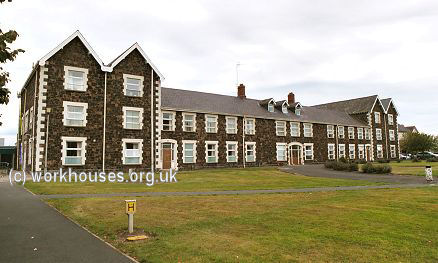
Lisburn main block from the north-west, 2003.
© Peter Higginbotham.
At the rear, a range of single-storey utility rooms such as bakehouse and washhouse connected to the infirmary and idiots' wards via a central spine containing the chapel and dining-hall which, unusually, later had a second storey added.

Lisburn main block, chapel and infirmary from the south, 2003.
© Peter Higginbotham.
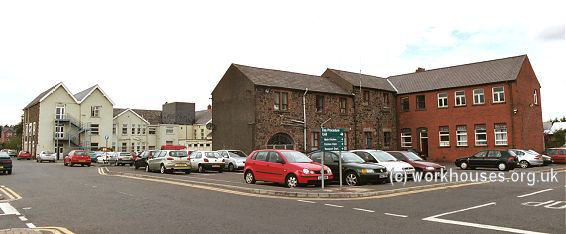
Lisburn main block and infirmary from the south-east, 2003.
© Peter Higginbotham.
During the famine in the mid-1840s, sleeping galleries were erected to accommodate an additional 100 inmates, with a further 60 in a converted coal store. A house was hired as a temporary fever hospital prior to 60-bed fever hospital being erected at the east of the workhouse. A graveyard lay just to its north.
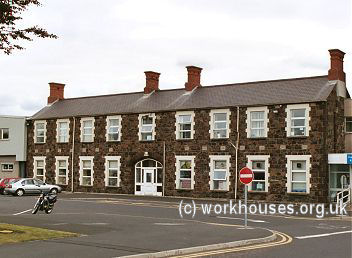
Lisburn fever hospital from the south-west, 2003.
© Peter Higginbotham.
At the 1901 census, the population of the Union was 46,463 with 10 officials and 223 inmates in the workhouse.
In 1895, Lisburn was visited by a "commission" from the British Medical Journal investigating conditions in Irish workhouse infirmaries. Their report listed a number of deficiencies including cramped wards, and poor ventilation and heating. Further details are available in the full report.
In 1921, the workhouse was closed and converted for use as the Lisburn and Hillsborough District Hospital, then later Lagan Valley Hospital.
Records
Note: many repositories impose a closure period of up to 100 years for records identifying individuals. Before travelling a long distance, always check that the records you want to consult will be available.
- Public Record Office of Northern Ireland, 2 Titanic Boulevard, Titanic Quarter, Belfast BT3 9HQ. Holdings include: Guardians' minutes (Feb 1839- Sep 1948); etc.
Bibliography
- Crossman, V (2006) Politics, Pauperism and Power in Late Nineteenth-century Ireland
- Gould, Michael H (1983) The Workhouses of Ulster
- Gray, P (2009) The Making of the Irish Poor Law, 1815-43
- O'Connor, J (1995) The Workhouses of Ireland
Links
- None.
Unless otherwise indicated, this page () is copyright Peter Higginbotham. Contents may not be reproduced without permission.


